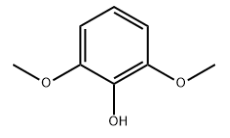
IdentificationPhysical DataSpectraRoute of Synthesis (ROS)Safety and HazardsOther Data
Identification
Product Name2,6-dimethoxyphenolIUPAC Name2,6-dimethoxyphenol Molecular StructureCAS Registry Number 91-10-1EINECS Number202-041-1MDL NumberMFCD00064434Synonyms2,6-DIMETHOXYPHENOL91-10-1SyringolPyrogallol 1,3-dimethyl etherPhenol, 2,6-dimethoxy-2-Hydroxy-1,3-dimethoxybenzene1,3-Dimethyl pyrogallate1,3-Dimethoxy-2-hydroxybenzeneAldrich1,3-Di-o-methylpyrogallol2,6-dimethoxy phenol2,6-dimethoxy-phenolPyrogallol dimethylether2,6-DwumetoksyfenolFEMA No. 31372,6-DimethoxyphenylCHEBI:9554UQT464H8KDTXSID20526072,6-Dimethoxyphenol(Chunk or Granule or Flakes)2,6-Dimethoxyphenol 99+%2,6-Dwumetoksyfenol EINECS 202-041-1MFCD00064434UNII-4UQT464H8K33-51-23DM2,6-dimetoxyphenol2,6-di-methoxyphenolbmse0102032,6-Dimethoxyphenol, 99%SCHEMBL156388CHEMBL1096522,6-Dimethoxyphenol (syringol)DTXCID0031180FEMA 31372,6-DIMETHOXYPHENOL Tox21_3039532,6-DIMETHOXY PHENOL BDBM504095352,6-Dimethoxyphenol, >=98%, FGAKOS000120263CS-W003972FS-1188HY-W0039722,6-Dimethoxyphenol, natural, >=96%CAS-91-10-12,6-Dimethoxyphenol, analytical standardNCGC00357187-01BP-10363D0639FT-0631436EN300-20299F13351A843720Q4214202,6-Dimethoxyphenol Pyrogallol 1,3-dimethyl etherQ-200214Z10447765425511-61-9Molecular FormulaC8H10O3 Molecular Weight154.16InChIInChI=1S/C8H10O3/c1-10-6-4-3-5-7(11-2)8(6)9/h3-5,9H,1-2H3InChI KeyKLIDCXVFHGNTTM-UHFFFAOYSA-N Isomeric SMILESCOC1=C(C(=CC=C1)OC)O
Patent InformationPatent IDTitlePublication DateWO2023/139053ARTHROPOD CONTROL COMPOSITIONS2023CN1165147275-fluoro-2,4-dioxo-3,4-dihydropyrimidine acetate derivative and preparation method and application thereof2023WO2022/226416MONOMERIC AND POLYMERIC COMPOSITIONS AND METHODS OF PRODUCING AND USING THE SAME2022CN115536498Method for oxidative coupling of substituted phenol under catalysis of butanedione2022CN112209975Method for preparing aromatic substances and small-molecular alcohols through catalysis of lignocellulose in one step2011
Physical Data
AppearanceWhite or off-white lyophilized powder
Melting Point, °C Solvent (Melting Point) 5049 - 5156 - 6153 - 5546 - 4756 - 5797 - 98diethyl ether
Boiling Point, °CPressure (Boiling Point), Torr262133 - 13417102 - 1032262.7
Description (Association (MCS))Solvent (Association (MCS))Partner (Association (MCS))UV/VIS spectrum of the complexCH2Cl2benzoquinone
Spectra
Description (NMR Spectroscopy)Nucleus (NMR Spectroscopy)Solvents (NMR Spectroscopy)Temperature (NMR Spectroscopy), °C Frequency (NMR Spectroscopy), MHzChemical shifts, Spectrum1Hchloroform-d1Chemical shifts, Spectrum13Cchloroform-d1Chemical shifts, Spectrum1Hdimethylsulfoxide-d680Chemical shifts, Spectrum13Cdimethylsulfoxide-d680Chemical shifts, Spectrum1Hchloroform-d1400
Description (IR Spectroscopy)Solvent (IR Spectroscopy)Bands, SpectrumBandsneat (no solvent, solid phase)BandstetrachloromethaneSpectrumCCl4
Description (UV/VIS Spectroscopy)Solvent (UV/VIS Spectroscopy)Absorption Maxima (UV/VIS), nmExt./Abs. Coefficient, l·mol-1cm-1470water264, 273, 280SpectrummethanolSpectrumhexane
Route of Synthesis (ROS)
Route of Synthesis (ROS) of 2,6-dimethoxyphenol CAS 91-10-1
ConditionsYieldWith hydrogen In decane at 349.84℃; under 22502.3 Torr; for 3h; Temperature; Autoclave;Experimental ProcedureGeneral procedure: Take 0.05g of catalyst and place it in the autoclave batch reactor, and then add 0.50g of 2,6-dimethoxyphenol and 10ml of n-decane into the autoclave batch reactor. The reactor was sealed, and the reactor was purged with nitrogen for 3 times, and then 3.0 MPa hydrogen was introduced. The temperature of the reactor was raised to 573K, and the stirring rate was 700 rpm and the reaction was continued for 2 hours.95.6%With hydrogen In water at 160℃; for 6h;Experimental ProcedureTo 1 g syringol in 40 ml of H20, HRO/H-β catalyst (100 mg) was added in a reactor vessel. The reactor vessel was then heated at 160 °C and H2 was added at a flow rate of 10 ml/min though a mass flow controller (MFC) for 6 h under stirring. After completion of the reaction, the catalyst was separated by using centrifuge and the obtained clear product mixture was analyzed by GC-MS. The reaction gave 100% conversion of guaiacol with 80% yield ofcyclohexanol.80%
Safety and Hazards
Pictogram(s)SignalWarningGHS Hazard StatementsH302 (100%): Harmful if swallowed Precautionary Statement CodesP264, P270, P301+P317, P330, and P501(The corresponding statement to each P-code can be found at the GHS Classification page.)
Other Data
No data available
DruglikenessLipinski rules componentMolecular Weight154.166logP1.178HBA0HBD1Matching Lipinski Rules4Veber rules componentPolar Surface Area (PSA)38.69Rotatable Bond (RotB)2Matching Veber Rules2
Quantitative Results1 of 265Comment (Pharmacological Data)Bioactivities presentReferenceProcess for producing alkylphenols2 of 265Comment (Pharmacological Data)Bioactivities presentReference Process for producing alkylphenols3 of 265Comment (Pharmacological Data)Bioactivities presentReferenceCannabinoids selective for the CB2 receptor4 of 265Comment (Pharmacological Data)Bioactivities presentReferenceStructure-activity relations in an imidazoline series prepared for their analgesic properties.
Use Pattern2,6-dimethoxyphenol CAS 91-10-1 can be used as a preservative to protect wood, paper, and other materials from microbial and fungal degradation. Volatile flavor constituents in shoyu (soy sause), wine and wood smoke. Used for the measure of laccase activity.
https://www.chemwhat.com/26-dimethoxyphenol-cas-91-10-1-4/
Comments
Post a Comment